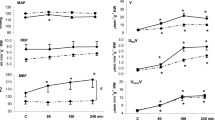Abstract
There has been no study comparing the advantage and disadvantage of various antihypertensive agents during surgery for pheochromocytomas because the study is difficult in clinical setting. In the present experiments using dogs, after increasing the arterial blood pressure with norepinephrine, we decreased it to the baseline with sodium nitroprusside (SNP), adenosine triphosphate (ATP), or phentolamine (PE) and compared the hemodynamic changes. A hyperdynamic state was found with ATP and with PE, but not with SNP. The norepinephrine-induced pulmonary hypertension could be successfully treated with SNP, but not with ATP or PE. The reason for these differences are thought to be the different vasodilative properties on peripheral arteries and veins. We conclude that agents that dilates the arteries and veins should be used to regulate the arterial pressure during surgical removal of a pheochromocytoma.
Similar content being viewed by others
References
Desmonts JM, Marty J: Anesthetic management of patients with pheochromocytoma. Br J Anaesth 56:781–789, 1984
Doi M, Ikeda K: Sevoflurane anesthesia with adenosine triphosphate for resection of pheochromocytoma. Anesthesiology 70:360–363, 1989
Murata K, Sodeyama O, Ikeda K, Fukunaga AF: Prevention of hypertensive crisis with ATP during anesthesia for pheochromocytoma. Journal of Anesthesia 1:162–167, 1987
Groudal S, Bindslev L, Sollevi A, Hamberger B: Adenosine: A new antihypertensive agent during pheochromocytoma remova!. World Journal of Surgery 12:581–585, 1988
Tinker JH, Michenfelder JD: Sodium nitroprusside: pharmacology, toxicology and therapeutics. Anesthesiology 45:340–354, 1976
Gerson JI, Allen FB, Seltzer JL, Parker Jr FB, Markowitz AM: Arterial and venous dilatation by nitroprusside and nitroglycerin —Is there a difference?— Anesth Analg 61:256–260, 1982
Pouler H, Covell JW, Ro Jr J: Effects of nitroprusside on venous return and central blood volume in the absence and presence of acute heart failure. Circulation 61:328–337, 1980
Hoka S, Siker D, Bosnjak ZJ, Kampine JP: Alteration of blood flow distribution and vascular capacitance during induced hypotension in deafferented dogs. Anesthesiology 66:647–652, 1987
Lagerkranser M, Irestedt L, Sollevi A, Andrean M: Central and splanchnic hemodynamics in the dog during controlled hypotension with adenosine. Anesthesiology 60:547–552, 1984
Sollevi A, Lagerkranser M, Irestedt L, Gordon E, Lindqvist C: Controlled hypotension with adenosine in cerebral aneurysm surgery. Anesthesiology 61:400–405, 1984
Kaplan JA: Treatment of perioperative left heart failure. Cardiac anesthesia 2nd. Ed. Edited by Kaplan JA. New York, Grune and Station, pp. 983–984, 1987
Kien ND, White DA, Reitan JA, Eisele JH Jr: Cardiovascular function during controlled hypotension induced by adenosine triphosphate or sodium nitroprusside in the anesthetized dog. Anesth Analg 66:103–110, 1987
Finegan BA, Chen HJ, Singh YN, Clanachan AS: Comparison of hemodynamic changes induced by adenosine monophosphate and sodium nitroprusside alone and during dopamine infusion in the anesthetized dog. Anesth Analg 70:44–52, 1990
Harris P, Heath D: The human pulmonary circulation. Pharmacology of the pulmonary circulation. 2nd Ed. Edinburgh London and New York, Churchill Livingstone, pp. 185–188, 1977
Pace JB: Pulmonary vascular response to sodium nitroprusside in anesthetized dogs. Anesth Analg 57:551–557, 1987
Aviado DM, Micozzi MS: Systemic pharmacology of adrenergic activators and inhibitors: Effects on the respiratory system, Handbook of experimental pharmacology Vol. 54/2. Edited by Szekeres L. Berlin Heidelberg, New York, Springer-Verlag, pp. 28–30, 1981
Fishman AP: Dynamics of the pulmonary circulation, Handbook of physiology, Section 2, Circulation Vol. 2. Edited by Hamilton WF. Washington D.C., American Physiological Society. pp. 1726, 1963
Munoz A, Sassine A, Puech P: Antiarrythmic action of adenosine and ATP: Clinical aspects-Europian view, Cardiac electrophsiology and pharmacology of adenosine and ATP: Basic and clinical aspects. Edited by Pelleg A, Michelson EL, Dreifus LS. New York, Alan R. Liss, pp. 255–300, 1987
Sohn YZ, Hong JC, Katz RL: Antiarrythmic and hemodynamic responses to epinephrine in dogs anesthetized with halothane. Anesth Analg 61:423–429, 1982
Burnstock G: Purinergic receptors in the heart. Circ Res 46:I-175–182, 1980
Author information
Authors and Affiliations
About this article
Cite this article
Murata, K., Takahashi, H. & Ikeda, K. Comparative cardiovascular effects of SNP, ATP and phentolamine during norepinephrine-induced hypertension in dogs. J Anesth 5, 396–403 (1991). https://doi.org/10.1007/s0054010050396
Received:
Accepted:
Issue Date:
DOI: https://doi.org/10.1007/s0054010050396




